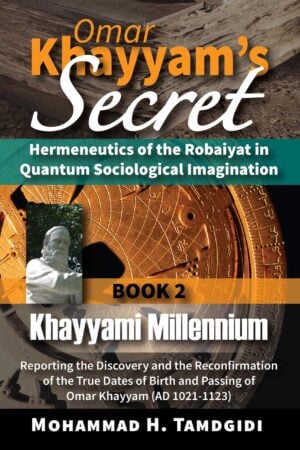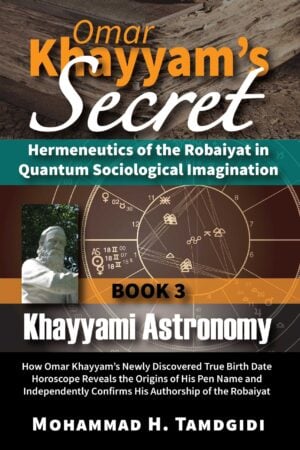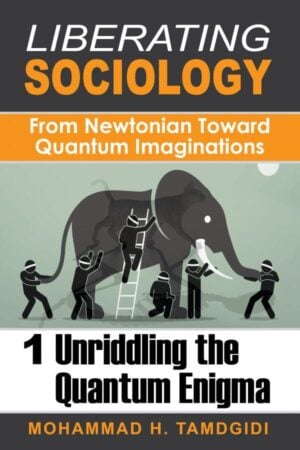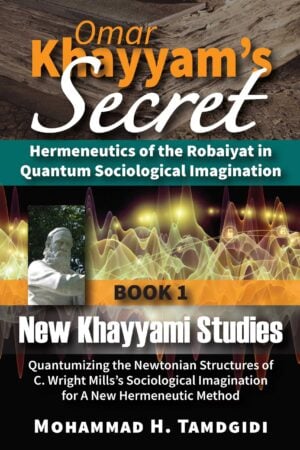Book Section: CHAPTER V—Did Omar Khayyam Secretively Author A Robaiyat Collection He Called “Book of Life”?: Solving the Manifold Riddles of His Robaiyat Attributability — by Mohammad H. Tamdgidi
$20.00
This essay titled “Did Omar Khayyam Secretively Author A Robaiyat Collection He Called “Book of Life”?: Solving the Manifold Riddles of His Robaiyat Attributability” is the fifth chapter of the book Khayyami Art: The Art of Poetic Secrecy for a Lasting Existence: Tracing the Robaiyat in Nowrooznameh, Isfahan’s North Dome, and Other Poems of Omar Khayyam, and Solving the Riddle of His Robaiyat Attributability, which is the seventh volume of the twelve-book series Omar Khayyam’s Secret: Hermeneutics of the Robaiyat in Quantum Sociological Imagination, authored by Mohammad H. Tamdgidi.
Description
Abstract
This essay titled “Did Omar Khayyam Secretively Author A Robaiyat Collection He Called “Book of Life”?: Solving the Manifold Riddles of His Robaiyat Attributability,” is the fifth and last chapter of the book Khayyami Art: The Art of Poetic Secrecy for a Lasting Existence: Tracing the Robaiyat in Nowrooznameh, Isfahan’s North Dome, and Other Poems of Omar Khayyam, and Solving the Riddle of His Robaiyat Attributability, which is the seventh volume of the twelve-book series Omar Khayyam’s Secret: Hermeneutics of the Robaiyat in Quantum Sociological Imagination, authored by Mohammad H. Tamdgidi.
In this chapter, Tamdgidi argues that the overall thesis of Omar Khayyam’s Robaiyat as having been a secretive collection of quatrains organized in an intended logical order can explain and unriddle the manifold riddles of cohereability, integrability, reconcilability, decipherability, stylizability, concealability, documentability, and translatability contributing to the attributability riddle of the Robaiyat to him. He posits, and in the forthcoming volumes of this series will demonstrate, that the lost quatrains comprising the original collection of Robaiyat have become extant over the past centuries, such that we can now reconstruct the original collection more or less as it had been originally meant to be organized as a ‘book of life’ by Omar Khayyam. We therefore confront basically a jigsaw puzzle of how to put back together the original collection in order to make sense of the masterpiece Khayyam had intended to leave as a keepsake magnum opus for his posterity.
There has been an ocean of literature increasingly accumulated, especially over the last two centuries, sharing and exploring not only the Robaiyat attributed to Omar Khayyam, but also asking whether they can be attributed to him. As far as the challenge of identifying those Robaiyat attributable to him is concerned, we can spend volumes, beside studying the attributed quatrains themselves, exploring the material by others to learn about who said what when and where in terms of the views expressed in the debates and the methods proposed and used to solve the riddle, claimed to be successful or not. Before we can list and study the quatrains themselves, in other words, it may appear to make more sense to review prior attempts made by others to find a way of sifting the authentic quatrains from others.
However, doing so will certainly end up repeating the repeated failing efforts in solving the riddle of Khayyam’s Robaiyat attributability since over the last century and a half in particular, not only has it become increasingly apparent that no one has succeeded in finding a way of solving the riddle of Khayyam’s Robaiyat attributability, but also even those who have claimed to have found better ways of doing so have fallen on hard grounds themselves, often prefacing or concluding their efforts by stating that they do not claim their proposed way of solving the riddle is anything final.
The reason is that all past efforts in solving the riddle have tried, using a formal either/or logic reminiscent of the Newtonian billiard ball game analogy to go about solving Khayyam’s Robaiyat attributability problem. That is, trying to find a precise way of determining whether an attributed quatrain is or is not Khayyam’s, they think it is possible to juggle, more or less confidently, the attributable quatrains apart from others not attributable to him. However, as Tamdgidi argues in this chapter, there is simply no way of being able to solve the riddle of the Robaiyat attributability by way of applying such a logic, since the problem essentially is not and can never be solved as an empirical one.
The reason is that there is no way of repairing and retracting the natural and historical calamities and events that over the centuries resulted in the destruction forever of some manuscript records remaining from Khayyam’s time and thereafter. For this reason, no one can confidently claim that the so-called “old manuscripts” that have survived from past centuries are the only such sources that ever existed, and for the same reason there is no way of proving, or not, whether the later manuscripts were themselves not based on previous older manuscripts that no longer exist, but were legitimate sources for their compilations.
To put it differently, there were no all-inclusive libraries or archives in earlier centuries that could have exhaustively stored all that was written or copied from manuscripts surviving Khayyam’s time, and anyone claiming—in the absence of a manuscript directly written by Khayyam, one that has yet to be found—that their study of “old manuscripts” is a sound and reliable basis for offering either/or logical argumentations and conclusions regarding the riddle of Khayyam’s Robaiyat attributability is only misleading himself (or herself), and others.
The riddle of the Robaiyat attributability can never be an empirical problem to solve, because it is essentially a fuzzy problem involving probabilities, requiring the application of fuzzy logical approaches based on both/and logical reasoning, unless in specific cases we find such solid basis for making precise conclusions. For this reason, the accumulated historical knowledge and tradition of numerous generations of scribes, readers, and commentators, suggesting that this or that quatrain belongs to Khayyam must be respected seriously and considered to be a helpful measure for making probability judgments. And it is for this reason also that relying on Omar Khayyam’s other definitively attributable writings must play a central role in advancing research and offering reasonable judgments about the attributability of quatrains to the historical Omar Khayyam.
The method introduced and applied in this series, framed in quantum sociological imagination, has aimed at advancing such an alternative approach to solving the riddles of Khayyam’s life and works, because it finds it more helpful and reasonable to apply both/and logical reasoning to problems that are essentially fuzzy, rather than being empirical in nature. Moreover, by way of deconstructing and showing the unreasonableness of defective methods and argumentations, we can also achieve reasonable progress in eliminating false narratives that can never solve the riddle since they can be shown as being inherently self-contradictory and deficient for the purpose of arriving at viable solutions to the riddle of Khayyam’s Robaiyat attributability.
In Tamdgidi’s view, the riddle of attributability of the Robaiyat has essentially been a riddle of understanding them, not as individual quatrains here or there, but as parts of a wider collection. If Khayyam intended his collection to be a unitary tale of his life and evolving worldview, we should expect any discussion of the necessity of the collection’s secretiveness to be discussed in the collection itself, not in his other publicly available and intended treatises.
If we encounter a riddle of reconcilability (of the Robaiyat with other works of Khayyam) when studying the Robaiyat, we cannot expect to solve that riddle by just focusing on the Robaiyat themselves, and not seriously and systematically read and engage with Khayyam’s other philosophical, theological, scientific, and literary works; in fact, read carefully, we may find that even in those public treaties he may have offered hints regarding what his poetic project could have been. We have learned much about this by studying carefully his Nowrooznameh, in fact, in the course of which we have been introduced to a whole series of discourses about art, metaphors, tropes, and secrecy that would make it possible to reconcile his public works with his private poetic creations more reasonably and meaningfully.
Khayyam’s Nowrooznameh serves, in Tamdgidi’s view, as a mediating text that brings Khayyam’s public and private (poetic) writings into interpretive contact with one another and should have been given much more serious attention by scholars. Unfortunately, the latter has not been the case and the translation and the study of the book as included in this volume will hopefully make such an integrative study of all of Khayyam’s work possible for future generations of Khayyami scholars.
When we examine Khayyam’s publicly available treatises, we always find that he begins them with a note on his authorship of them, even going into some details, at times, regarding the background and historical or biographical context that made the writing of the treatise necessary. If the Robaiyat also was conceived as a collection of poems, a book of life, that had a unitary organization, then we should even expect that he would start it with a note on his authorship with it.
Considering the Robaiyat as having been a collection of interrelated and logically flowing quatrains would clearly make the attribution of its constituent quatrains to Khayyam much more feasible than the nearly impossible task of trying to prove the attributability of the quatrains on an individual basis, found in isolation across many old or newer manuscript.
Therefore, the riddles of reconcilability (with other treatises), cohereability, and integrability (of inner organization and coherence of the collection itself) would be better and more effectively solved by studying the Khayyami quatrains in relation to one another, and in relation to the wider treatises of Khayyam, without making any a priori prejudgments in advance about which quatrains are to be included or not.
The criterion for choosing the quatrains, in other words, should not be based on external factors and presumptions about the manuscripts in which they were found, but on the hermeneutic study and understanding of what each quatrain tells us as part of a broader story of the wider quatrains. We can then eliminate inauthentic quatrains, not based on external factors, but based on how the quatrain fits in with others in the overall collection and how they all fit in the broader worldview of Khayyam as expressed and evident in his public treatises. We may even find that some Khayyami quatrains become a reliable basis for authenticating other Khayyami quatrains.
Khayyam was not a duplicitous scholar who would have written anything in public in sharp contradiction with what he wrote in private. At best, given the conditions of his time and his own personal preferences for privacy or needed secrecy, he would have truncated his public text or expressed his thoughts in veil, or simply remained silent, but not expressed views in contradiction with his private thoughts and feelings. For this reason, we should consider the study of the Khayyami Robaiyat and his public treatises in tandem to offer us a fruitful path toward solving the riddle of understanding the Robaiyat as the flip side of solving the riddle of their attributability.
Regarding the increase, sudden or not, of the number of quatrains being attributed to Khayyam ignores the possibility that increased interest in his poetry can lead to an increase in search of old personal, public, or university archives or libraries, leading to the discovery of quatrains that had not even been detected before and are as authentic as any previously found. Besides, those who regarded such increases in the number of quatrains with suspicion usually ignore the fact that indeed such increases slowed down and even stopped for a long while, while the fame and interest in Khayyam’s poetry remained the same or even increased.
If interest in Khayyam’s quatrains is automatically an impetus for composing more or less Khayyami-sounding quatrains from scratch without being authentically his, they must explain why no more such quatrains are found in particular historical periods or since then, not considering the sporadic new quatrains that are still being found and judged to be by Khayyami scholars and experts as being possibly authentically Khayyam’s. And amid the above we should also consider cases of some quatrains found to be actually questionable in terms of their attributability, but some scholars who prefer or like them due to their own views of what Khayyam was trying to say philosophically or theologically, they chose, purely as a matter of personal inclination, to include them among likely attributable ones, when there can be no sound basis for judging them as belonging to Khayyam.
In the last section of this chapter, Tamdgidi draws on all of Khayyam’s writings studied in the earlier books of this series, including the present volume, to present an interpretation of his Robaiyat as a secret poetry collection intended by him to serve as a way of bringing him a lasting spiritual existence in his this-worldly afterlife, that is, posthumously. A secretive approach to composing his Robaiyat poetry allowed Khayyam to fulfill various goals as follows:
The primary purpose of composing his secretive poetry was to achieve lasting spiritual existence in a this-worldly afterlife, that is, posthumously. He was not composing the poems for a contemporary audience, even though early on some of his quatrains had been shared, leading him to realize how they could be misunderstood apart from the overall “book of life” he was composing for his posterity. That is why we do not find anything substantial among his contemporaries reporting him as having composed the Robaiyat.
The secretive approach allowed him to survive his troubling times amid which many free-thinkers and scientists feared for their lives. Although this factor helped him to save his head, it was not a primary reason for its secretive nature, given the primary purpose the collection served as stated above.
The secrecy allowed him to express his views as much as he wished to do so in a personal way, without a need for limiting himself to the extent he did in his public writings. But such public expression limitations were not done duplicitously, as if what he wrote privately in his Robaiyat were in contradictory contrast with his publicly expressed views.
Even though Khayyam did not have to worry about expressing his views in his Robaiyat privately, the primary purpose for which he composed them, that is, for lasting posthumous spiritual existence, required that he compose them in such a way that future troubling times and differences of opinions others may have about his views would not prevent them from being read and spread across later generations. For this reason, the language of poetry, written in the pearly secretive style that he also adopts in his Nowrooznameh allowed him to say what he wished in veil, the essence of his views being wrapped in an outer shell of poetic narratives and metaphors that could be read and liked by many publicly, while their inner meanings could survive beneath the surface tales. So, the poetic language allowed him to pursue a secretive style of writing in plain sight, allowing for their public proliferation in later times.
The Robaiyat collection was not meant to serve a public purpose during his own lifetime, but served the purpose of his own self-reflective spiritual purification, as such writing could provide him with an opportunity to establish an inner conversation between his own mind, heart, and sensibilities as well. Writing can be healing, and he used the opportunity to heal himself of the troubles and depressive conditions amid which he found himself personally and socially in his times. For this reason, it is important to consider the organization of such a collection as not having had a random order but as proceeding in such a way that would imply the evolution of his thoughts and feelings in the course of a lifetime.
The poetic language expressed in the simplest way also had the advantage of reaching out outwardly to his audience across future generations, not just to their minds, but also to their the hearts and their sensibilities. This was important pedagogically as well as necessary to serve his primary purpose of assuring his lasting posthumous spiritual existence.
What should we expect to be the structure of a Robaiyat collection Khayyam had composed secretively as a private account, in poetic form, of his “book of life”?
Since it was considered by him to be a private, secretive work, we should expect it to be a substantively self-contained work of art. By that Tamdgidi means, a work that in itself would explain why it was being written, why it had to be treated as a secretive, private, work, and what its tropes and metaphors are supposed to mean and represent.
Given it was meant to be a record of his life, it would not be organized alphabetically in any way, but would be thematically organized, the themes themselves following a logical reasoning progression, while their constituent quatrains would also be organized according to a logical order that would demonstrate an evolution of thinking, feelings, and sensibilities.
The self-contained nature of the collection would imply that any of its tropes and metaphorical structures would be introduced and developed in the work itself, rather than relying on any external source or writing for their understanding, since the latter would betray the private and secretive premise of the collection.
Given an initial inquiry Tamdgidi made, in Book 2, of this series, the collection would be comprised of 1000 quatrains, beginning with opening quatrains that offer a statement about its secretive authorship by Khayyam (as found in his public treatises as well), and with ending quatrains that would serve as signature statements for the overall collection.
The collection will engage critically with the astrological imagination and in particular at once acknowledging and challenging its fatalistic interpretations, while involving a dialogical and conversational structure as also found in Khayyam’s other Persian qasideh or ghazal as studied in the previous chapter.
Given the deep interest Khayyam had in the topic of succession order amid his philosophy of existence and his creationist evolutionary worldview, we should expect significant engagement with such topics in the collection as well.
Given the “book of life” nature of the collection, however, Khayyam’s work would be both personally self-reflective while engaging with the themes having to do with the troubling times in which he lived, the cosmic order as imagined through his philosophical, theological, and astrological/astronomical imaginations, drawing on tropes and metaphors related to such themes. Engaging with topics of necessity and accident, fate and chance, foes and friends, prayer dialogues, touching on matters dealing with wealth and poverty, sorrow and happiness, living in the here and now, would also be expected, as will be concerns with passage of time, transient nature of existence, and concerns for matters of life and death.
The above, therefore, have provided us with the necessary insights to solve the riddle of attributability of the Robaiyat in the forthcoming volumes of the series using a both/and logical method, when we will finally explore the Khayyami quatrains in order to solve the 1000-piece jigsaw puzzle of how they can all fit together into the whole constituting his intended “book of life.”
Recommended Citation
Tamdgidi, Mohammad H. 2024. “CHAPTER V—Did Omar Khayyam Secretively Author A Robaiyat Collection He Called “Book of Life”?: Solving the Manifold Riddles of His Robaiyat Attributability.” Pp. 573-676 in in Omar Khayyam’s Secret: Hermeneutics of the Robaiyat in Quantum Sociological Imagination: Book 7: Khayyami Art: The Art of Poetic Secrecy for a Lasting Existence: Tracing the Robaiyat in Nowrooznameh, Isfahan’s North Dome, and Other Poems of Omar Khayyam, and Solving the Riddle of His Robaiyat Attributability. (Human Architecture: Journal of the Sociology of Self-Knowledge: Vol. XX, 2024. Tayyebeh Series in East-West Research and Translation.) Belmont, MA: Okcir Press.
Where to Purchase Complete Book: The various editions of the volume of which this Book Section is a part can be ordered from the Okcir Store and all major online bookstores worldwide (such as Amazon, Barnes&Noble, Google Play, Apple, and others).
Read the Above Publication Online
To read the above publication online, you need to be logged in as an OKCIR Library member with a valid access. In that case just click on the large PDF icon below to access the publication. Make sure you refresh your browser page after logging in.








